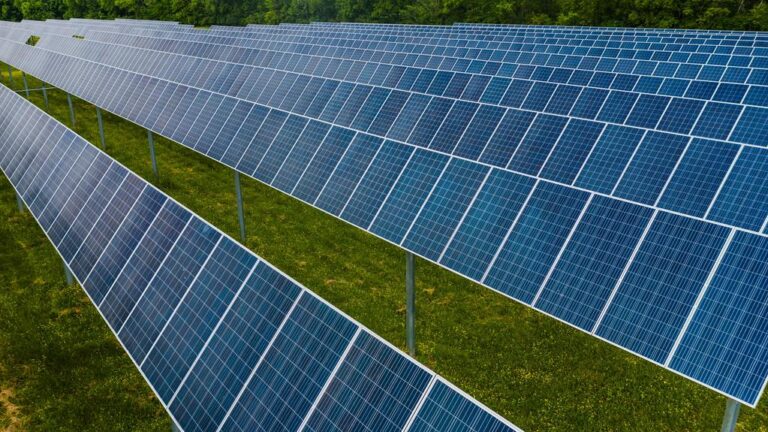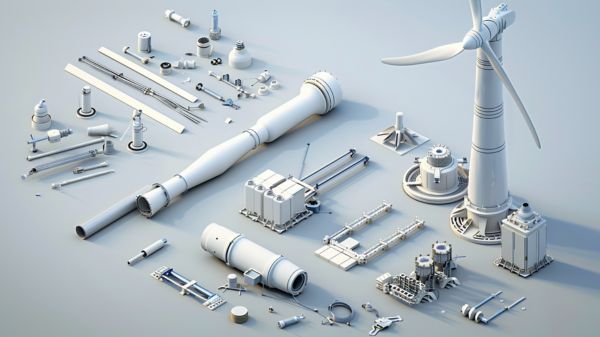Optimizing Wind and Solar Hybrid Power Systems in 7 Steps
To optimize wind and solar hybrid power systems in 7 steps, start by evaluating renewable energy potential through data on solar radiation and wind speeds. Then, conduct exergy analysis to assess energy flows and explore advanced energy storage technologies.
Evaluate wind and solar complementarity to improve energy production efficiency. Employ optimization algorithms like Genetic Algorithms and Simulated Annealing. Techno-economic assessments and cost-saving strategies play important roles in achieving peak system performance.
Each step contributes to maximizing efficiency and sustainability. Mastering these steps is essential for harnessing the full potential of wind and solar hybrid power systems.
Key Takeaways
- Evaluate wind and solar complementarity for efficient energy production.
- Utilize optimization algorithms like Genetic Algorithms for system enhancement.
- Consider energy storage technologies to reduce wind and solar curtailment.
- Assess renewable energy potential with precise resource input data.
- Enhance system performance with exergy analysis for energy flows.
Assessing Renewable Energy Potential
To accurately evaluate the renewable energy potential of wind and solar power systems, reliable data on solar radiation levels and wind speeds is essential. Average solar radiation levels, typically around 5.43 kWh/m, offer valuable insights into the potential of solar energy technologies in hybrid power systems.
Similarly, understanding the average wind speed, such as the commonly observed 3.8 m/s, plays a significant role in evaluating the wind power generation capacity of these systems. The availability of precise resource input data is fundamental for accurately gauging the renewable energy potential of hybrid systems.
Conducting Exergy Analysis for Energy Flows
Conducting Exergy Analysis for Energy Flows provides a detailed examination of the quality and potential of energy transfers within hybrid power systems. This analytical approach goes beyond traditional energy analysis by evaluating not only the quantity but also the quality of energy in a system.
By quantifying the efficiency of energy conversions, exergy analysis helps in appraising the sustainability of energy utilization. It enables the identification of areas where energy losses occur and offers insights into enhancing overall system performance.
Through this method, a more thorough understanding of the energy dynamics within hybrid power systems is achieved, leading to informed decision-making for optimization strategies. Embracing exergy analysis facilitates a deeper exploration of the intricate energy pathways, shedding light on opportunities for enhancing sustainability and efficiency in power generation.
Exploring Energy Storage Technologies
Exploration of cutting-edge energy storage technologies is pivotal in advancing the efficiency and reliability of wind and solar hybrid power systems. Compressed Air Energy Storage (CAES) systems play an important role in reducing wind and solar curtailment by storing excess energy efficiently.
The integration of the Parzen window method aids in extracting essential features from historical data, contributing to the improvement of energy storage systems in hybrid setups. Additionally, the application of Genetic Algorithms enables the determination of the best capacity for energy storage solutions within these systems.
Evaluating Wind and Solar Complementarity
The optimization of wind and solar power systems hinges on a thorough assessment of the complementarity between wind speed and solar radiation to enhance energy production efficiency.
By evaluating wind and solar complementarity, energy production can be maximized by identifying periods of high energy generation based on the correlation between wind speed and solar radiation.
This understanding is vital for minimizing reliance on grid electricity and improving the performance of hybrid systems that utilize both energy sources.
Quantifying the overlap in energy generation patterns between wind and solar sources plays a key role in achieving peak energy production levels in a hybrid system.
Effective evaluation of wind and solar complementarity also facilitates the implementation of energy management and storage strategies, ensuring a consistent power supply.
By utilizing data on the availability of wind and solar resources, it becomes possible to strike the ideal balance between the two sources, further enhancing the efficiency of energy production in hybrid systems.
Employing Optimization Algorithms
Optimization algorithms play a vital role in enhancing the efficiency of wind and solar hybrid power systems. The algorithm selection process, performance evaluation metrics, and iterative improvement techniques are pivotal aspects in optimizing these systems.
Algorithm Selection Process
In the domain of optimizing wind and solar power systems, the process of selecting algorithms for system optimization is a critical step towards achieving efficient and effective results. When considering hybrid power systems, optimization algorithms such as Genetic Algorithms, Simulated Annealing, and Particle Swarm Optimization play a pivotal role.
Factors like convergence speed, solution accuracy, and computational efficiency are key considerations in this selection process. Each algorithm may excel in different optimization scenarios depending on the system’s complexity and objectives.
Choosing the right algorithm is crucial to efficiently optimize the performance and economics of hybrid power systems. By carefully evaluating these aspects, one can select an algorithm that best suits the specific needs of the wind and solar hybrid power systems.
Performance Evaluation Metrics
Evaluating the effectiveness of wind and solar hybrid power systems involves utilizing performance evaluation metrics that are enhanced through the use of optimization algorithms.
- Capacity factor
- Levelized cost of energy
- Energy payback period
- System reliability
Optimization algorithms such as genetic algorithms, simulated annealing, and particle swarm optimization play a significant role in improving system performance. These algorithms help in maximizing energy production and minimizing operational costs.
Iterative Improvement Techniques
Utilizing advanced iterative improvement techniques through optimization algorithms is essential in enhancing the operational efficiency and performance of wind and solar hybrid power systems.
Optimization using algorithms such as genetic algorithms, simulated annealing, and particle swarm optimization plays a vital role in refining system design and addressing the optimization problem within these systems.
Performing Techno-Economic Assessments
Conducting comprehensive techno-economic assessments is essential in determining the financial feasibility and optimizing the performance of wind and solar hybrid power systems.
These assessments evaluate the cost-effectiveness of hybrid power generation, considering factors such as capital costs, operational expenses, energy production, and financial viability. To explore further into this important process, consider the following key points:
- Hybrid nature of the system
- Cost analysis and optimization
- Renewable energy integration
- Impact on overall efficiency
Achieving Cost Savings and Efficiency
Enhancing cost savings and operational efficiency in wind and solar hybrid power systems requires a strategic approach focused on optimizing energy production and system performance. By integrating both wind and solar sources, hybrid systems can achieve maximum power generation potential while minimizing operational costs.
Proper system design and optimization techniques are vital in ensuring the seamless integration and utilization of renewable energy sources. Advanced energy management strategies play a key role in achieving ideal system operation, leading to economic benefits through efficient energy utilization.
Selecting appropriate optimization software packages and techniques is essential for fine-tuning hybrid power systems. Through continuous monitoring and analysis, system inefficiencies can be identified and rectified promptly, further enhancing overall efficiency.
By implementing cost-effective measures and streamlining energy management practices, wind and solar hybrid power systems can achieve significant cost savings while maximizing power generation. This proactive approach not only improves the economic viability of hybrid systems but also contributes to sustainable energy practices.
Related Post: The Ultimate Guide To Vertical Axis Wind Turbines.
Frequently Asked Questions
What Are the Steps in the Wind Energy Project?
Site selection and feasibility assessment lead turbine installation and maintenance. Grid connection and integration are essential for power generation and monitoring. Energy storage and backup improve reliability. Weather forecasting aids planning and efficiency. Performance tracking enhances overall project success.
What Are the Steps in the Wind Energy Production Process?
The wind energy production process involves turbine installation, wind resource assessment, blade design, power generation, maintenance schedule, grid connection, and energy storage. Each step is vital for harnessing wind power efficiently and contributing to sustainable energy production.
How Do You Optimize Wind Energy?
To optimize wind energy, focus on wind turbine efficiency, energy storage integration, power output maximization, resource assessment accuracy, wind direction utilization, and meticulous system design. Implementing advanced technologies and strategies can greatly enhance overall performance and sustainability.
What Is Optimization of Hybrid Renewable Energy Systems?
Energy integration in hybrid renewable systems optimizes system performance by balancing loads, enhancing cost efficiency, and integrating energy storage. It leverages weather forecasting for grid integration, ensuring seamless operation while minimizing costs and maximizing sustainability.
Conclusion
To sum up, optimizing wind and solar hybrid power systems involves a systematic approach:
- Evaluating renewable energy potential.
- Conducting exergy analysis.
- Exploring energy storage technologies.
- Assessing complementarity between wind and solar.
- Employing optimization algorithms.
- Performing techno-economic assessments.
By following these steps, cost savings and efficiency can be achieved in the design and operation of hybrid power systems, ultimately maximizing the utilization of renewable energy sources.






